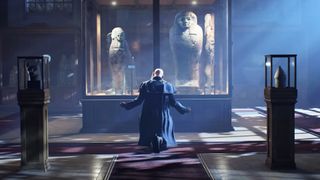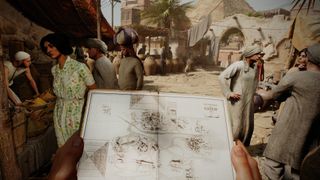Our 8K test system
PC built by Stormforce Gaming
Motherboard: Asus PRIME Z-790P LGA 1700
Processor: Intel Core i9-13900K, 24 Cores / 32 Threads
CPU Cooler: Corsair iCUE H100i 240mm ELITE CAPELLIX Liquid CPU Cooler
GPU: Nvidia GeForce RTX 4090
Storage: 1.0TB Seagate FireCuda 530 M.2 NVMe SSD
Case: Corsair iCue 5000X RGB
RAM: Corsair Vengence 32GB DDR5 4800MHz
Screen: LG 55NANO966PA
So, it’s official: with Nvidia announcing the RTX 5090 at CES 2025, the RTX 4090’s reign as the most powerful consumer graphics card in the world is drawing to a close. Team Green’s new flagship GPU could get us tantalizingly close to native 8K gaming, if Nvidia’s boasts are to be believed. The 5090’s 32GB of GDDR7 memory, compared to the 4090’s 24GB of GDDR6X could have a huge impact when pushing extreme resolutions (and not only is there more memory, it’s much faster as well).
However, until the RTX 5090 goes on sale on January 30, the RTX 4090 remains the top GPU when it comes to pure performance – which means that it’s still your best chance of doing justice to the lofty ambitions of modern, graphically intensive, games.
Indiana Jones and the Great Circle is exactly that; a graphically demanding game that could either prove to be either a great showcase for the aging card, or a sign that the RTX 5090’s time has indeed come.
The new Indy is one of those all-too-rare licensed games that completely nails the vibes of the thing it’s based on – an especially impressive feat considering just how iconic the first three Indiana Jones films are.
Much of its charm likes in the way that the story, acting and music all combine to make you really feel like you’re Dr Jones. The fact that it’s also one of the most graphically impressive games of all time certainly helps up the immersion as you walk around photo-realistic locations around the globe.
A recent patch added full ray tracing (also known as Path Tracing) to the game, which ups the realism of the graphics even further with stunning lighting effects and reflections. As a graphical showpiece, then, I was keen to see just how well it plays on our RTX 4090-equipped testing rig at 8K. However, before the game even launched I was struck with a fear that I’ve never had before when playing on an RTX 4090 PC: will Nvidia’s (currently) most powerful gaming GPU be enough?
Rough specs
This fear was ignited when Bethesda released the PC requirements for the game ahead of its release; these stated that an Nvidia RTX 4090 is required to run the game at full ray tracing at ultra settings.
Sure, this is for a level of graphical fidelity that many people might not feel the need to achieve, but most of us PC gamers want our rigs to be able to offer the highest possible graphical options. And for the past few years, I can’t think of a time the RTX 4090 was ever mentioned in any game’s recommended specifications – it was simply that overpowered. When playing at 4K, I was always able to whack up settings to the max with abandon.
However, with the RTX 4090 now appearing in a game’s recommended specs, albeit for the absolute highest possible settings, it looks like the ambitions of game makers is catching up to the hardware. And, while the RTX 4090 certainly doesn’t belong in a museum just yet, it might also be a sign that the arrival of the RTX 5090 is timely.
So, for possibly the last time, let’s really put the RTX 4090 through its paces and see how well it handles playing Indiana Jones and the Great Circle at the incredibly demanding resolution of 7680 × 4320.

I understand its power now
My initial tests were certainly impressive. Running at a native 8K resolution with graphical settings set to ‘Super Ultra’ (surely a sign that developers MachineGames really had fun pushing its visuals), our RTX 4090-powered test rig managed 53fps (frames per second) on average.
Considering just how good this game looks, that’s very impressive. The PC version of Indiana Jones and the Great Circle uses ray tracing (an advanced way of calculating lighting and shadows for greater realism), but in a rather unique move (which again shows MachineGames’ commitment to visual excellence), ray tracing is turned on by default – and can’t be turned off.
Considering the game (like the movies it’s based on) takes you on a tour of exotic locations, including (slight spoiler alert) jungles, deserts and iconic historical monuments, having realistic lighting really heightens the immersion and helps make you feel like Indiana Jones.
It also explains why the required specifications for the game are so high, as you need a modern GPU capable of ray tracing. Ray tracing is a very intensive effect, and in the past I’ve seen how turning it on can lead to big drops in frame rates. The fact that the RTX 4090 can play Indiana Jones and the Great Circle with ray tracing enabled (albeit at its lowest setting), and at just a bit below the golden 60fps benchmark I aim for when gaming at 8K, is pretty awesome. It’s proof that even if its successor is about to go on sale, the RTX 4090 is still an incredible graphics card.
But what happens when ‘full’ ray tracing is turned on?

Fortune and glory, kid. Fortune and glory
Arriving after the game launched, ‘full ray tracing’, which is also known as ‘full path tracing’, ups the realism of lighting, shadows and reflections even further.
It enables GPUs to simulate real-world lighting by tracing the paths of light sources as they reflect and scatter over objects in a scene, and it applies to both direct and indirect lighting. So, things like shadows, shades and colors through transparent surfaces are all replicated realistically. These seemingly small details all add up to an incredible level of realism and immersion, and Indiana Jones and the Great Circle is a great example of this.
Moving under the dense foliage of a forest, you can see shafts of light break through between the leaves, while the leaves that block the light are themselves illuminated in an incredibly lifelike way. The same is true when sunlight shines through a stained glass window in another location in the game, with the colors scattered across the ground in a genuinely realistic manner.
Shadows cast by the sun shining through clouds, vegetation and other objects, and light reflecting off water or glossy surfaces are also present – and as you might expect, all of this is extremely demanding on your graphics card. Turning ‘Full RT’ on to even its lowest ‘Medium’ setting absolutely tanks the frame rates at 8K, with the RTX 4090 hitting just 14fps on average. Pretty, sure, but absolutely unplayable.
This is where DLSS (Deep Learning Super Sampling) comes in. Arguably one of the most important bits of gaming tech of recent times, DLSS was created by Nvidia and utilizes AI to upscale images from a lower resolution to a much higher one. This means there’s less pressure on the GPU to render games at resolutions such as 4K, as they can render it at the more manageable 1080p, then DLSS upscales it to 4K.
The idea is that this drastically improves performance without negatively impacting image quality, and we’ve seen in past 8K tests that it can really make a difference, especially when targeting high resolutions without having to lower graphic settings. Over the years, DLSS has matured – we’re currently on DLSS 3, with DLSS 4 having been announced alongside the new RTX 5000 series GPUs, and the results have been steadily improving.

Turning on DLSS to its ‘Quality’ setting, which as the name suggests prioritizes quality over performance, so the starting resolution is higher and minimizing the use of upscaling, gives us an instant boost. With full ray tracing still on and set to medium, our test rig hit 40fps on average – a big leap that makes the game much more playable.
Changing DLSS to ‘Balanced’ allowed the RTX 4090 to hit 59fps without full ray tracing on. This offered a great combination of visual fidelity and fluid movement, with the game essentially running at that golden 60fps, whilst also showing off some of the advanced graphical bells and whistles, including limited ray tracing.
Turning full ray tracing back on, the frame rate again plunged to 41fps, showing just how intensive those extra effects are. Full ray tracing is still set to its lowest setting – I dread to think what putting it any higher would do (and I’d only be able to think, as when I did try out of morbid curiosity, the game crashed).
With DLSS set to ‘Performance’, which lowers the rendered resolution – meaning DLSS upscaling has to do more of the heavy lifting – I managed to get 50fps with full ray tracing on medium. As I was getting closer to 60fps with full ray tracing, I used another tool in Nvidia’s arsenal: frame generation.
This feature uses AI to generate frames based on the game you’re playing and insert them between real frames. As games show multiple frames every second, the idea is that these generated frames are indistinguishable from the real ones – and using this, you can then increase the fps of the game you’re playing, leading to a much smoother experience.
However, the reason why I left it so long to turn on frame generation is that my previous experiences of it haven’t been that impressive. When it first came out, I tried it on Cyberpunk 2077, and found the generated frames led to a general fuzziness of images.
But, like DLSS, Nvidia has been working on improving frame generation (and we’re set to get a more advanced version alongside DLSS 4), and using it in Indiana Jones and the Great Circle was a much better experience. There wasn’t a major impact to graphical quality, and with a bump to frame rates (54fps), the game did indeed feel smoother and more responsive to play.
Finally, I set DLSS to ‘Ultra Performance’, which renders the game at 1440p and then upscales to 8K. This did the trick and our 8K test rig hit 60fps with full ray tracing on medium. However, the strain on upscaling from such a comparatively low resolution (plus generating frames) was clearly taking its toll, as there was noticeable pop-in and some other visual artifacts that while not game-breaking, were distracting enough to take away from the overall immersion.

Conclusion: The Nvidia RTX 4090 does not belong in a museum… yet
So, when all is said and done, is this one last hurrah for the RTX 4090 as the sun sets on its time as the most powerful gaming GPU in the world? Or is it a sign that the RTX 5090’s arrival is just on time?
In a way, it’s a little bit of both. The fact that out of the box, the RTX 4090 was able to run such a graphically intensive game at a perfectly playable 53fps, while at its highest graphical settings at 8K, and even with some limited ray tracing effects, proves that regardless of what comes next, the RTX 4090 will remain an absolute beast of a graphics card. If you’re lucky enough to own one, it’ll continue to give you years of excellent gaming performance, especially if you’re gaming at 4K.
I’ve been running these 8K tests for three generations now, starting with the RTX Titan, then the RTX 3090 and finally the RTX 4090. Throughout my time with the 4090, I’ve been constantly impressed by the card’s performance, with the GPU getting well over 30fps at native 8K resolution in many modern games – something I once thought would be impossible due, to the demands of running a game at 7680 x 4320 pixels. The RTX 4090 has been the closest we’ve come to 8K gaming, and the advancements with DLSS and frame generation have helped 8K become more achievable than ever. It certainly leaves an impressive legacy that the RTX 5090 will struggle to live up to.
However, the advanced graphical effects used in Indiana Jones and the Great Circle also really put the RTX 4090 through its paces, and highlighted the limitations of the current generation of DLSS and frame generation.
While Nvidia has revealed that DLSS 4 will be coming to RTX 4000 series GPUs as well as RTX 5000 cards, the new Multi Frame Generation feature, which will generate up to three additional frames per real frame, will be exclusive to RTX 5000 cards.
This, combined with the technical leaps that the RTX 5090 is claimed to come with, means that if you really want to enjoy the future of gaming that Indiana Jones and the Great Circle hints at, it looks like the RTX 5090 will be the GPU to get.

